Plants of Chester Creek
The Chester Creek Trail is home to hundreds of species of wildflowers, vines, shrubs, trees, and grasses with a blooming season that extends from March through October.
Learn more about the biodiversity and seasons of Chester Creek in the attachments below.
**A huge thank you to John “Mac” MacFarland for putting this together and sharing your vast ecological knowledge!!
Common Fruit and Seedpods
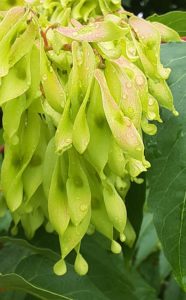
Alianthus Seedpods

American Bittersweet Fruit
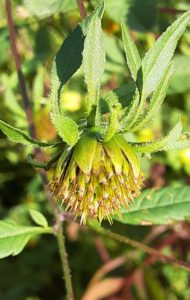
Beggar Ticks (Sticktights) Seedpod

Black Cherry Fruit

Black Walnut Fruit

Box Elder Seedpods
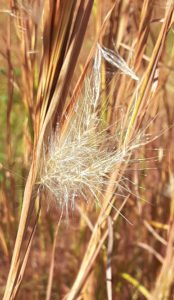
Broomsedge Bluestem Grass Seed

Bull Thistle Seedpod

Bur Cucumber Fruit

Canada Thistle Seeds
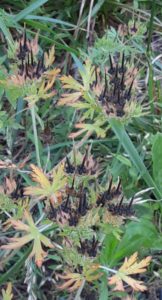
Carolina Cranesbill Seedpods
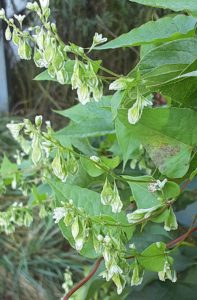
Climbing False Buckwheat Seedpods
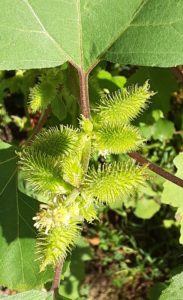
Clotbur (Cocklebur) Seedpods

Common Hop Fruit
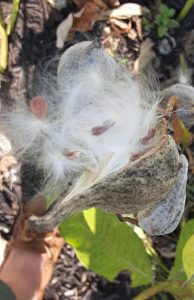
Common Milkweed Seedpod
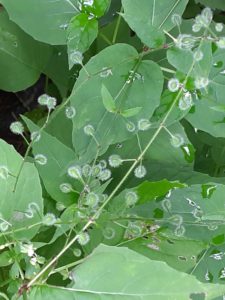
Enchanter’s Nightshade Seedpods
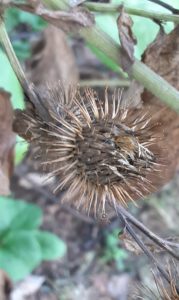
Great Burdock Seedpod

Hoary Tick-Trefoil Seedpods
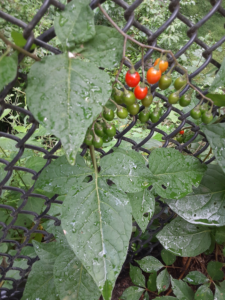
Nightshade (Bittersweet) Fruit

Pale Touch-Me-Not Seedpod

Paulownia Seedpods
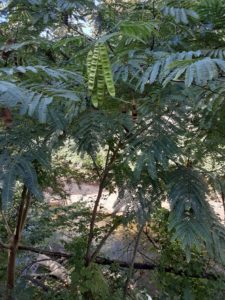
Persian Silk Tree Seedpods

Pilewort Seedpods
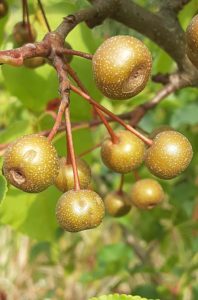
Pin Cherry Fruit

Plume Poppy Seedpods
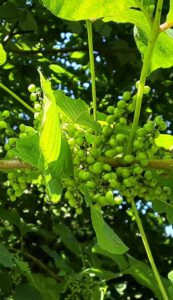
Poison Ivy Berries

Pokeweed Berries
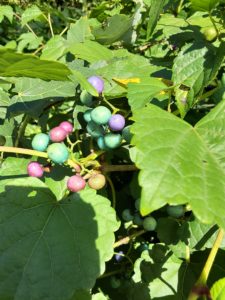
Porcelain Berry Fruit
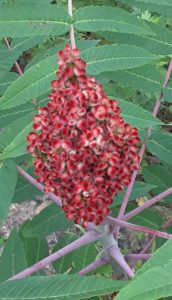
Smooth Sumac Berries

Spicebush Berries
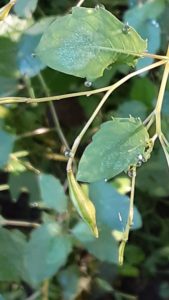
Spotted-Touch-Me-Not Fruit

Tartarian Honeysuckle Berries

Virginia Stickseed (Beggar’s Lice) Seedpods
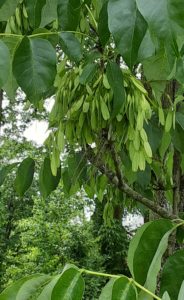
White Ash Seedpods

White Avens Seedpods
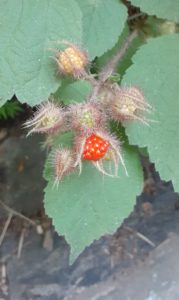
Wineberry Fruit
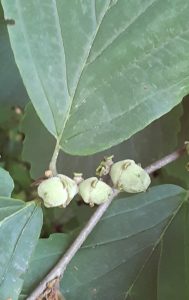
Witch Hazel Seedpods
Common Early Spring Plants
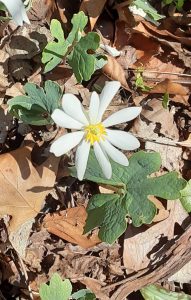
Bloodroot
(Sanguinaria canadensis)
The leaves and flowers sprout from reddish rhizome containing a bright orange/red sap, which is the reason for the genus Sanguinaria, meaning “bloody” in Latin. It was used as a red dye by tribes living in areas of its growth. It produces a single basal leaf with five to seven lobes that enclose the white flower until it blooms. Every morning it opens and at night it closes. It is insect pollinated but produces no nectar.

Common Chickweed
(Stellaria media)
This species is grown as a vegetable crop and ground cover for both human and poultry consumption, thus its name. It is edible and nutritious and often used raw in salads. Its genus name is derived from the Latin meaning “star”. Flowers are white and small with five very deeply lobed petals. Over the years, it has been used medicinally for iron-deficiency anemia as well as skin diseases and bruises.
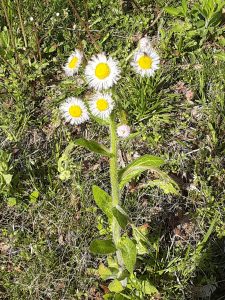
Common Fleabane
(Erigeron philladelphicus)
This species is native to North America and is a member of the daisy family. Introduced to Europe and Asia, it is considered an invasive species there. It can be found growing along roadsides, in fields, in thickets, and in open woods. The flower heads are borne in arrays of as many as 35 heads. Each head may sometimes contain as many as 400 pink or white ray florets surrounding yellow disc florets.
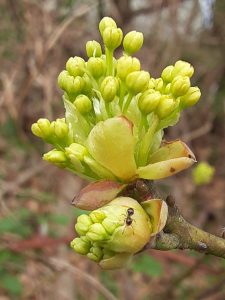
Common Spicebush
(Lindera benzoine)
Common spicebush is a member of the laurel family. Its leaves, buds, and new growth twigs can be made into a tea. The fruits can be dried, ground, and used as an allspice substitute. Local tribes used it as a treatment for multiple ailments. Many animals feed on the leaves, twigs, and berries, including deer, game birds, and songbirds. When crushed, its leaves emit a spice-like aromatic odor, thus its name.
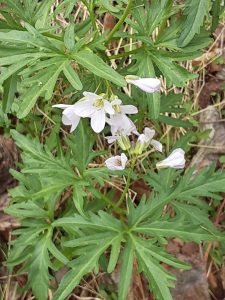
Cut Leaved Toothwort
(Caddamine concagtentata)
The roots of this plant can be washed, chopped, and ground in vinegar to be used as a horseradish substitute. Its native habitats include rich woods, wooded bottomland, limestone outcrops, and rocky banks and bluffs. The leaves are on long petioles, deeply palmately dissected into five toothed segments. Its white to pinkish flowers are held above the foliage in a spike, which ripens into an elongated pod.
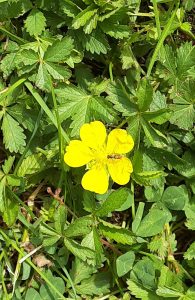
Dwarf Cinquefoil
(Potentilla canadensis)
This species of cinquefoil is characterized by leaves made up of five wedge-shaped leaflets. The toothed leaflets are rounded, but lack teeth below the middle. The stems are densely silver-hairy. The flowers are five-petaled and yellow in color. Along with the leaflets on each leaf, this gives way to the name from the Latin “cinque” meaning five. They grow from an overground runner of a stem, and its presence is an indicator of impoverished soil.
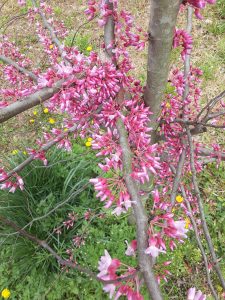
Eastern Redbud
(Cercis canadensis)
The flowers of this southern shrub are light to dark magenta pink in color and appear in clusters on bare stem before the leaves. Long-tongued bees pollinate the flowers. The leaves are alternate, simple, and heart shaped, long and wide, thin and papery, and may be slightly hairy below. The flowers can be eaten fresh or fried. Tribes in the area consumed the flowers raw or boiled, and ate the roasted seeds.
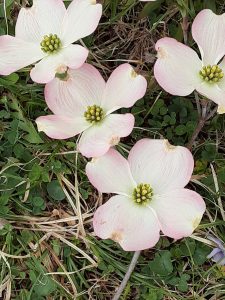
Flowering Dogwood
(Cornus florida)
This flowering tree is commonly planted as an ornamental in residential and public areas. The leaves are opposite, simple, ovate, long and broad, with an apparently entire margin. They turn a rich red in autumn. The flowers are individually small and inconspicuous. Around twenty flowers are produced in a dense, rounded, umbel-shaped flower head surrounded by four conspicuous large white or pink bracts (not petals) with a distinct notch at the apex.
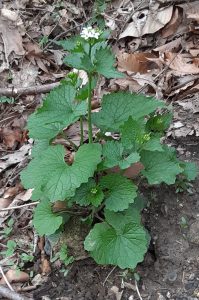
Garlic Mustard
(Allaria petiolata)
This member of the mustard family is a highly invasive species introduced by European settlers. In the first year of growth, plants form clumps of round wrinkled leaves that when crushed smell like garlic. The plants flower the next spring producing cross-shaped white flowers in dense clusters. The crushed seeds are used as a mustard substitute. It is one of the oldest spices used in Europe.
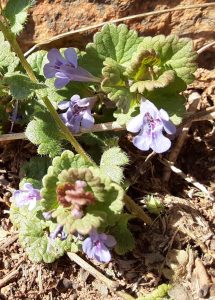
Gill-Over-The-Ground
(Glechoma hederacea)
This member of the mint family is also called Ground-ivy, Creeping Charlie, and Run-Away-Robin. It thrives in moist shaded areas, but also tolerates sun. It thrives in lawns and around buildings as it survives mowing. In the United States, it is considered an invasive species. But, in Europe it was cultivated and used in the brewing of ale before the current use of hops, as well as a medicinal compound.
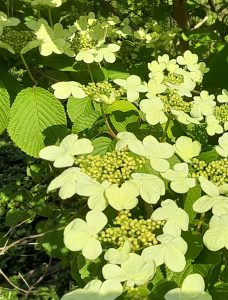
Hobblebush
(Viburnum lantanoides)
This perennial shrub has pendulous branches that take root where they touch the ground forming obstacles, which easily trip walkers-hence the common name. It grows to heights of six feet and has opposite large heart-shaped leaves. The flowers form large, flat clusters and are very white. The Algonquin reportedly rubbed its mashed leaves on the head to treat migraines. The Iroquois as a blood medicine.
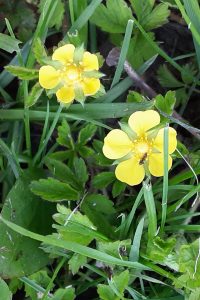
Indian Strawberry
(Duchesnea indica)
This species is one that spreads along the surface of the ground by long running over-ground stems. Its leaves are compound and made up of three leaflets that are ovate and pointed with deeply cut edges. They are found on a separate stalk from the flowers. The flowers are yellow in color and spring from the leaf nodes. The five yellow petals are backed by distinct three-lobed bracts., exceeding the petals and sepals. The fruit is strawberry-like, but inedible.
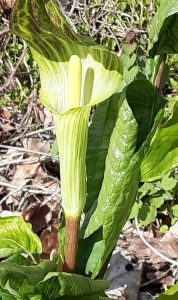
Jack-In-The Pulpit
(Arisaema atrorubens)
This species is distinctive with its three-part leaves and flowers contained in a spadix that is covered by a hood. The oxalic acid found in the plant is poisonous if ingested. However, if cooked, it can be eaten as a root vegetable. If sliced and dried, it can be eaten like potato chips, or ground into flour. The oxalate crystals give it a peppery flavor. It has been used to treat sore eyes, rheumatism, and snake bites.
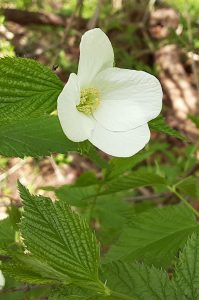
Jetbead
(Rhodotypos scandens)
This species is a deciduous shrub in the Rose family. It is native to Asia. It grows to a height of five feet with opposite simple ovate leaves. The flowers are white and have four petals. The fruit is a cluster of one to four shiny jet-black berries. These are highly toxic, and may be fatal if eaten. It was introduced into the ornamental nursery trade around 1866.

Lesser Celandine
(Ficaria verna)
This species is a member of the Buttercup family, and contains a compound known as protoanemonin. Contact with crushed leaves can cause itching, rashes, or blistering on the skin. Ingesting the toxin can cause nausea, vomiting, dizziness, spasms, and paralysis. Cooking of the plant eliminates its toxicity. It is also known as Pilewort because it has historically been used to treat piles (hemorrhoids).
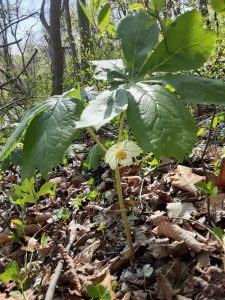
Mayapple (Mandrake)
(Podophyllum petatum)
These woodland plants typically grow in colonies derived from a single root. The stems grow to 15 inches tall with palmately lobed umbrella-like leaves. Flowering stems produce a pair of leaves with flowers found in the axils of the leaves. The flowers are white with six to nine petals and mature into a yellow fleshy fruit. All parts of the plant are poisonous, including the fruit until it ripens and turns yellow.
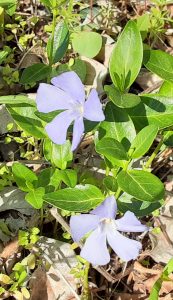
Myrtle (Periwinkle)
(Vinca minor)
This species exhibits a lavender flower with five asymmetric petals that create a pinwheel effect. It has a star outline in its center. Its leaves are glossy, evergreen, lanceolate, and opposite on the stem. It exists as a creeping ground cover, spreading from gardens. It is extensively cultivated as a groundcover because the plants are low and spread quickly. When escaped, it can become a difficult invasive species to control.

Pin (Fire) Cherry
Prunus pennsylvanica
This species may grow to heights of up to fifty feet. Neither its soft wood nor fruit have any commercial value, but the wood can be used as firewood or chips, and the fruit can be used for jams, jellies, and preserves. It can regenerate by both seed and sprout. Seeds accumulate over prolonged periods in the soil and may remain viable for a hundred years. Flowers occur in small groupings of five to seven individuals.
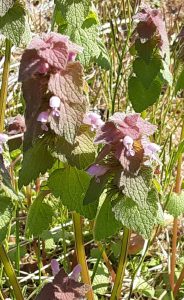
Purple Dead-Nettle
(Lamium purpureum)
Like all mints, this species is characterized by its square stem. It is native to Europe and Asia, so, as an escape becomes invasive. Though superficially similar to species of true nettles in appearance, it does not sting, hence the name. It is extremely beneficial to pollinating bees. Young plants can be used in salads or finely chopped for sauces. Herbalists use it for many remedies including as a salve for itchy skin.
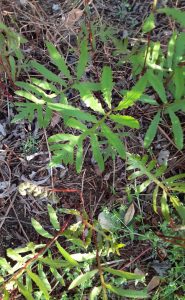
Sensitive Fern
(Onclea sensibilis)
This species derives its name from its sensitivity to frost, the fronds dying quickly when first touched by it. It has remained essentially unchanged over millions of years as exhibited by a fifty-seven million year old fossil of Paleocene epoch flora. It propagates by both spore dispersion and rhizome growth. It is cultivated as an ornamental plant in gardens, but can become aggressive if not controlled.

Slender Speedwell
(Veronica filiformis)
This species is a native of Turkey, introduced to the United Kingdom in 1808 and first reported in the United States as an escape in 1838. The corolla is four-lobed and bluish with a white tip with the top lobe being the largest. In Ireland, it was sewn into the clothing of travellers for good luck. It reproduces from separated sections of stem and rhizome, so is easily dispersed, especially by mowing.
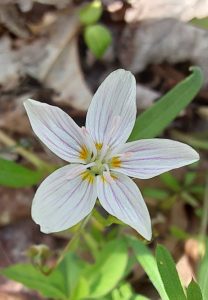
Spring Beauty
(Claytonia virginica)
This species honors the colonial Virginian botanist John Clayton. It is a trailing perennial plant, overwintering through a tuberous root. Its individual flowers bloom for only three days. Its seeds are released from a capsule fruit and easily spread by insects. The Iroquois would eat the raw roots, believing they prevented conception. The leaves can be cooked in salted water, although not choice eating.
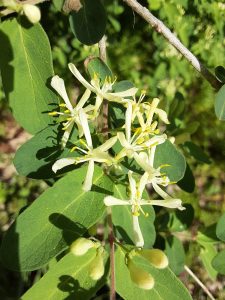
Tartarian Honeysuckle
(Lonicera tatarica)
This species is native to Siberia and was introduced to the United States as an ornamental plant in 1752. Of cats that do not respond to catnip, one third respond to its aromatic wood. Ingestion of the berries by humans causes diarrhea, vomiting, and abdominal pain, but not death. The berries are, however, beneficial to wildlife. Birds spread its seeds through their droppings. The flowers have a sweet smell.
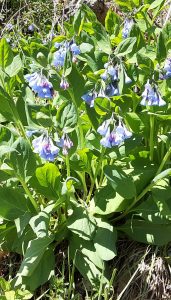
Virginia Bluebells
(Mertensia virginica)
This species is a spring ephemeral plant with bell-shaped sky-blue flowers. The flowers have five petals that are fused into a tube. Bees can pollinate this flower, but because of its funnel shape they must hover, making them rare pollinators. Butterflies are the most common pollinators as they can perch on the edges. Early tribal societies used it for medicines, but there is no scientific proof that they work.
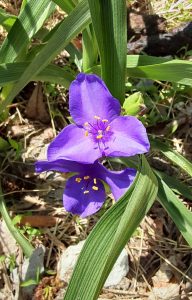
Virginia Spiderwort
(Tradescantia virginina)
This species is a perennial herbaceous plant with alternate, simple leaves, on tubular stems. The flowers can be blue, purple, magenta, or white. It prefers moist soils, but can adapt to drier garden soils. It is a southern plant that has escaped in the north, as it is commonly grown in gardens, due to its attractive flowers. As an escape, it is found growing wild along roadsides and railway lines.

Yellow (Tulip) Poplar
(Liriodendron tulipfera)
This species of tree with its characteristic tulip like flowers can grow to heights of one hundred fifty feet. The largest tree is Eastern North America is a Tulip Poplar in the Great Smoky Mountains that is one hundred ninety-two feet tall. It is valued by landscapers for its use as a shade tree, for its wood as building material due to its resistance to termites, and as a sculpting medium for wood carvers.

Yellow Trout Lily
(Erythronium americanum)
This species derives its name from its gray-green leaves mottled with brown or gray, which allegedly resemble the coloring of Brook Trout. It blooms in early spring before the trees growing above them develop leaves. This time allows them unobstructed access to sunlight for photosynthesis and time to grow when soil nutrient levels are highest. The flowers close at night and open again in the sunlight.
Common Late Spring Plants

American Bittersweet
(Celastrus scandens)
This species is a sturdy perennial vine that may have twining, woody stems that are thirty feet or longer. The stems are yellowish-green to brown and wind around other vegetation, sometimes killing it. It has tiny, scentless flowers that grow at the tips of the branches. It has colorful, orange fruits that are the size of a pea, which reminded colonists of “Solanum” species, thus the common name. These fruits are poisonous to humans, but are favorites of birds.
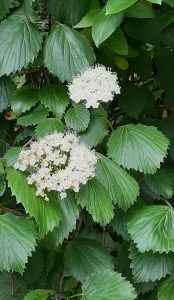
Arrowwood
(Viburnum dentatum)
This species is a small shrub and, like most Vibrurnum species, has opposite, simple leaves. In this species they are ovate with heavily notched edges. This foliage turns yellow to red in the fall. Its white flower clusters are found in umbrels at the ends of short stems and mature into bluish berries that are held in a drupe. These are a food source for many songbirds. Indigenous people used the young straight stems to make arrow shafts, thus the common name.
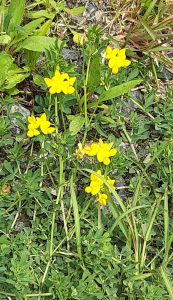
Birdsfoot Trefoil
(Lotus corniculatus)
This species is a member of the Clover family and thus a legume able to enrich soils. It is characterized by having leaves with five leaflets. There are three clover-like leaves on each stalk above two more at the base, appearing like large stipules. The flowers are yellow in color turning red later, and grown is a cluster of three to six blooms. It can be erect or prostate. Its slender seed pods suggest the foot of a bird, thus the common name.

Black Locust
(Robinia pseudoacacia)
Another common name for this medium-sized hardwood deciduous tree is “False Acacia”. This is a translation of its specific name from the Greek “pseudo”, meaning fake. It is not native to our area, but has been planted for years as an ornamental tree. Its dark blue-green compound leaves have a contrasting lighter underside. It is shade-intolerant. The cream-white flowers with a yellow blotch in the center are arranged in loose drooping clumps.
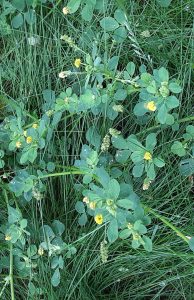
Black Medick
(Medicago lupulina)
This species is a prostrate plant that suggest hop clovers, but has downy stems and produces black seedpods, thus the common name. Its clover-like three-leaflet leaves ae often minutely spine-tipped. Its yellow flowers are small and grow from individual stalks from the leaf axils. It is an annual or short-lived perennial growing each year from adventitious buds on the roots. Like other legumes, the roots contain nodules hosting nitrogen-fixing bacteria.
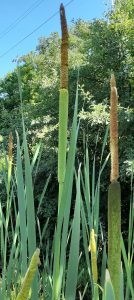
Broadleaf Cattail (Bulrush)
(Typha latifolia)
This species is a tall marsh plant that grows to as much as nine feet in dense stands. Its leaves are erect and bladelike. The stems are stiff and support a sausage-like brown head of minute, tightly packed pistillate flowers. Above this is a slender “tail” of paler staminate flowers. In this species the staminate “tail” touches the pistillate part. The rhizomes, young flower spikes, young shoots, and rootstocks were all used for food or medicine by indigenous peoples.
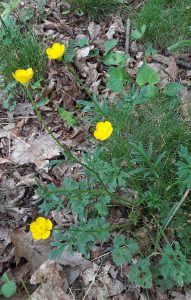
Bulbous Buttercup
(Ranunculus bulbosus)
This species, like all in the Buttercup family, is characterized by having deeply cut, palmate, three-segment leaves on distinct petioles. These are found in a basal arrangement below a tall flower stalk. It is a small, hairy plant with deep yellow, five-petaled flowers at the top, which display reflexed sepals. It gets its name from a bulb-like swollen underground stem, which is situated just below the soil surface. The Latin term, “Rana”, refers to the frog’s-foot appearance of its leaves.

Butterfly Weed (Orange Milkweed)
(Asclepias tuberosa
This perennial species is a member of the milkweed family but not milky, when the hairy stems are broken. Its leaves are long, broad, lanceolate, and spirally arranged along its stem. Its flowers resemble other milkweed species, except for their being orange. Each flower has five petals and five sepals and are arranged in wide umbels. These produce long spindle-shaped pods. Because Monarch butterflies do not favor it, it is not suitable for butterfly gardens.

Canada Thistle
(Cirsium arvense)
This perennial species with its numerous small lilac flowerheads and spiny foliage is extremely beneficial for pollinators, like bees and butterflies, that rely on its nectar. It forms extensive. colonies and tends to thrive in areas of moderate sunlight. Given this, it is one of the worst invasive species. Its wind-blown seeds are an important food for goldfinch and other finches. Its foliage is used as a food source for twenty species of butterflies and several species of aphids.
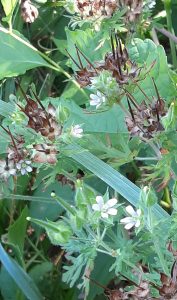
Carolina Cranesbill
(Geranium carolinianum)
The short-stalked pinkish-white flowers of this species are found crowded in compact clusters. The ethanol extracted from this plant has been effective in treating Hepatitis B infections. Its flowers are short lasting but are visited by bees and flower flies. Quail and Mourning Dove are known to eat its seeds, which develop from the flowers into clusters of bright brown seedpods looking much like the bills of cranes, thus the common name.
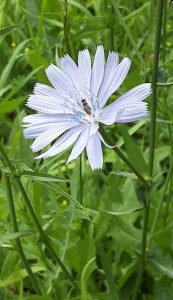
Chickory
(Cichorium intybus)
The flowers of this species are clear blue and stalkless. They hug its rigid, nearly naked stem. Its rays are square-tipped, and fringed. Its basal leaves are dandelionlike. Its rays begin to close at noon, and remain so until dawn. Its leaves have been cultivated for salad greens and its roots, once baked and ground, used as a coffee substitute or additive. One brand on the market with this feature is Luzianne.
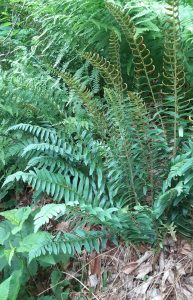
Christmas Fern
(Polystichum acrostichoides)
This is a perennial, evergreen fern native to Eastern North America. Its common name derives from the evergreen fronds, which are often still green at Christmas. Also each pinnae on a frond when held correctly looks like Santa Claus in his sled. It grows in a clump with its fronds arising from a central point. It produces fertile fronds that bear light brown spores on the edges of the upper pinnae.

Cleavers
(Galium aparine)
This species is characterized by very scratchy, recurved prickles on its stems. Its small leaves are arranged in whorls around the stems, and are generally eight in number, distinguishing it from other species of Galium. Its star-shaped white flowers are found on small stalks growing from the leaf axils. Its creeping straggling stems branch and grow along the ground, attaching themselves to other plants by small hooked hairs, which grow out of their stems and leaves.
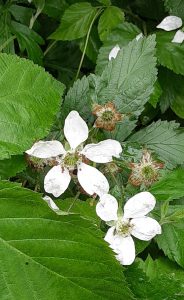
Common Black Berry
(Rubus allegheniensis)
This species is a member of the rose family and is commonly called “Bramble”. It is an erect plant attaining heights between five and eight feet. Usually, it forms dense thickets. Its leaves are alternate, compound, ovoid, and have toothed edges. Its stems are adorned by an armor of stiff prickles. It has five-petaled white flowers which mature into glossy, deep-violet to black edible aggregate fruit.
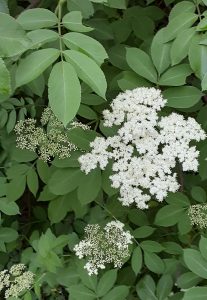
Common Elderberry
(Sambucus canadensis)
This species is deciduous shrub growing up to twenty feet in height. Its leaves are arranged in opposite pairs and pinnate with five to nine leaflets. Its very small, five-petaled, white flowers are held above the foliage in clusters called coymbs. The fruit is a dark purple to black berry produced in drooping clusters. Traditional methods of consuming elderberry include wine, jams, jellies, and syrups, all of which cook down the fruit and strain out the seeds.

Common Milkweed
(Asclepias syriaca)
This species is a stout downy plant. Its characteristic drooping flower clusters are found mostly in the leaf axils. Their color varies from rose to lavender to brownish purple. These mature into pointed gray-green seedpods with a warty aspect that burst open to disperse their feathery white seeds on the wind. More than 450 species of insect feed on this species, but it is most known as the most important food source of the endangered Monarch Butterfly caterpillars.
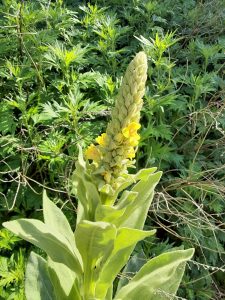
Common Mullein
(Verbascum thapsus)
This species is a hairy biennial plant that can grow up to six feet or more. During its second year of growth, small yellow flowers are found densely grouped on a tall stem, which grows from a large rosette of basal leaves. During its first year of growth, it produces only the rosette. These leaves are large and extremely soft. It has been suggested that indigenous peoples used these for innersoles in their moccasins, but they were not introduced until the arrival of Europeans.
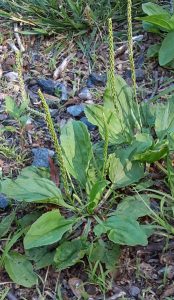
Common Plantain
(Plantago major)
This species is characterized by broad basal leaves and a long tight flower head. The leaves are ovate or spade-shaped and strongly ribbed with troughlike stems. The young, tender leaves can be eaten raw as salad greens, but the older stringier leaves must be boiled or eaten in stews. These leaves contain calcium and other minerals, and have been commonly used in folk medicine for skin poultices on wounds, sores, or insect stings.
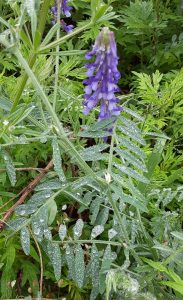
Cow Vetch
(Vicia cracca)
This species of vetch is finely downy and is similar to a pea in growth habit with climbing stems growing to five foot in length sending out noose-like tendrils that contact and securely fasten it to other plants. Its flowers are many, are blue-violet in color, and appear on long stalked one-sided spikes. The leaves bear eight to twelve pairs of leaflets and terminate in a that strangling tendril. Its flowers mature into tiny seeds born in a dark brown seedpod spotted with black.

Crown Vetch
(Securigera varia)
This species displays an umbel of bicolored pink and white flowers on creeping stems. Its leaves are divided into many small paired leaflets. It is native to Africa, Asia, and Europe but is commonly used throughout the United States and Canada for erosion control, roadside planting, and soil rehabilitation due to its ability, like other legumes, to fix nitrogen in the soil. Despite this benefit, it is toxic to horses and must be watched, but is not toxic to cattle, goats, and sheep.
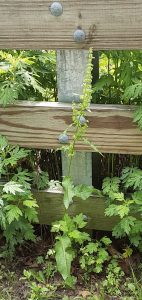
Curled Dock
(Rumex crispus)
This species is characterized by numerous small yellow-green flowers growing along a tall infloresence or stalk with scattered wavy-edged curled leaves ascending from a large basal rosette. The largest of these flower clusters is found at the top. The flowers mature into shiny, brown seeds encased in the calyx of the flower that produced them. This casing enables the seeds to float on water and get caught on animal fur, helping disperse them.
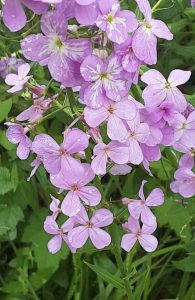
Dame’s Rocket
(Hesperis matronalis)
This species is a garden escape that resembles Phlox. However, it has four large, showy, petals to its flowers instead of five. Upon fertilization, the flowers become the long seedpods characteristic of the Mustard family in which it belongs. Its flowers may be pink, purple, or white. The strong scent of the flowers increases toward evening. From this, it has received the genus name, “Hesperis”, which is the Greek word for evening.

Day Lily
(Hemerocallis fulva)
This species is in fact is not a member of the Lily family. It is characterized by upward-facing, tawny, unspotted, orange blossoms on a leafless stem. Its name is derived from the fact that its flowers only open for one day. Once pollinated, they form botanical capsules. Its flowers are edible, but eating in excess can cause diarrhea. In cats, however, its ingestion may be fatal. Its leaves on separate stems are long and swordlike, and are grouped into opposite arching fans.
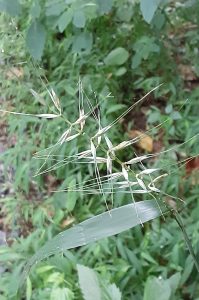
Eastern Bottle Brush Grass
(Elymus hystrix)
This species is a herbaceous perennial grass with alternate, simple leaves, on erect stems. It ranges from approximately two to five feet in height. Its flowers are white and grow in spikelets. There are usually two spikelets at each of the five to nine nodes on the stem. It has the ability to reproduce using its own pollen. It was among the first plants described by Carl Linnaeus in his survey of 1753. High in crude protein, it has a possibility as a crop for livestock.

English Plantain
(Plantago lanceolata)
This species is a familiar dooryard weed characterized by three-ribbed leaves and a long, grooved stalk topped by a short, bushy flower head. The basal leaves are lanceolate, and form a rosette. The inflorescence is ovoid and consists of many small, brown flowers with conspicuous white stamens. It is used frequently in herbal teas and other herbal remedies. Songbirds eat the seeds, and the leaves are eaten by rabbits. It can live anywhere, but does best in open areas.

False Solomon’s Seal
(Maianthemum racemosum)
This species has oval, pointed leaves, which alternate along the stem like ladder rungs, and a gracefully reclining stem, which is tipped with a spirea-like cluster of creamy white flowers. The fruit is a berry, at first whitish speckled with brown, later ruby-red. When ripe it is edible both raw or cooked, but may be poor in taste. Consumed in large quantities, it can act as a laxative. The most robust and profuse occurrences of this plant are typically found in partial shade.
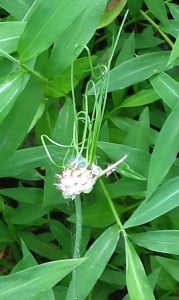
Field Garlic
(Allium vineale)
This species is a perennial, bulb-forming wild onion that exhibits either pink or white flowers or may be replaced by bulblets with tails. A single spathe is found below the bloom. Its leaves are hollow and ascend partway up the stem. As a substitute for garlic, it displays an unpleasant aftertaste. It imparts a garlic-like flavor and odor on dairy and beef products, when grazed on by livestock, and thus is considered a pestilential invasive weed throughout the United States.
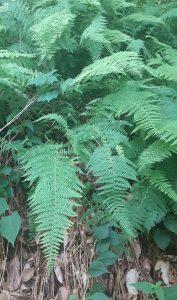
Hay-Scented Fern
(Dennstaedtia punctilobula)
This species is a deciduous fern with fronds growing up to three feet in length. Its fronds are bipinnate, with each pinnae alternating closely up the stem. Its spores are located at the inner edges of each. Its common name comes from the fact that crushing it produces an aroma of fresh hay. The presence of this fern influences the dynamics of the understory of many forests. It is not browsed by deer, so is readily able to take over and restrict the growth of tree seedlings.

Horse Nettle
(Solanum carolinense)
This species is not a true nettle but a member of the Tomato Family. It has large alternate widely-toothed, rough leaves, attached to prickly stems. When crushed, these leaves smell like potatoes. The flowers have five petals and are usually white or purple with yellow centers. The fruits are berries that resemble small tomatoes, turning from dark green with light green stripes to yellow when mature. Unlike tomatoes, all parts of the plant, including the fruit, are toxic.
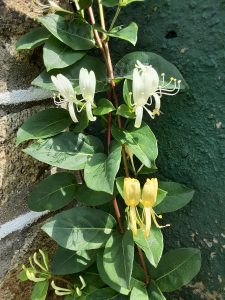
Japanese Honeysuckle
(Lonicera japonica)
This species, native to Asia, is a woody vine that is extremely difficult to eradicate. Its simple ovate leaves are found growing opposite each other along the winding stem. Its tubular flowers are white to buffy yellow in color and exhibit long, curved projecting stamens. When mature, they become black berries. Its dried leaves are employed in traditional Asian medicines, and the flowers are eaten by humans, who appreciate their sweet tasting nectar.

Lady’s Thumb (Redshank)
(Persicaria maculosa)
This annual species is a Smartweed in the Buckwheat Family. It has tight, spikelike, clusters of tiny pink or whitish flowers on knotted stems with a papery sheath at each joint. The stems are reddish, thus the common name, and the sheaths have fringes. It has narrow, alternate, linear leaves generally bearing a dark triangular blotch. Its fruit is a shiny black, three-edged achene. It does not tolerate lime, so liming is a means for controlling or eradicating it.
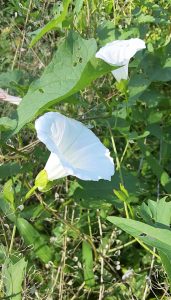
Large Bindweed
(Convolvulus silvatica)
This species is a member of the Morning Glory family. It is characterized by simple arrow-shaped leaves with blunt basal lobes that are arranged spirally around the stem. Its trumpet-shaped flowers may be white or pale pink with five darker stripes produced by the end of summer. It is a herbaceous perennial that twines around other plants, in a counter-clockwise direction. After flowering, the fruit develop as almost spherical capsules.
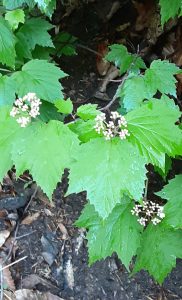
Maple Leaf Viburnum
(Viburnum acerifolia)
This species is a shrub about seven feet in height. Its leaves are opposite pairs, long and broad, with three to five lobes that have a serrated margin, resembling a Maple leaf, thus the species name, “acerfolia”, meaning “maple leaf”. The leaf margin has a fuzzy texture. These change to a variety of colors come autumn. Its flowers are white with five small petals, produced in terminal cymes, which mature into a small red to purple-black drupe. These berries can be made into jam.

Moth Mullein
(Verbascum blattaria)
This species is a flowering biennial plant, only producing flowers every other year. Its white or yellow flowers, with their purple centers, consist of five petals and five anther-bearing orange stamens covered in purple hairs, resembling a moth’s antennae, that are borne in a loose raceme on a tall stem, hence its common name. It has long been known to be an effective cockroach repellent, thus the species name “blattaria” derived from the Latin word for cockroach, “blatta”.
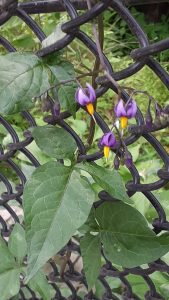
Nightshade (Bittersweet)
(Solanum dulcamara)
This species is vine-like bearing ovate leaves with two distinct lobes at the base. It flowers are five petaled, swept back, and deep violet to black in color with protruding yellow beaks formed by the anthers. The fruit appear as drooping clusters of egg-shaped berries turning from green to ruby red with maturity. Less toxic than other species of “Solanum”, the fruit have a sweet after taste, hence the common name. It was once thought to be effective against witchcraft.
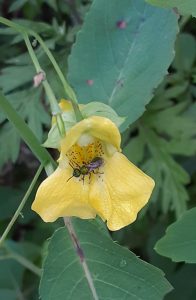
Pale Touch-Me-Not (Yellow Jewelweed)
(Impatiens capensis)
This species has pendent blossoms of pale yellow with distinct spurs. The stems are watery when broken, and the sap appears to give some relief from rashes and insect bites. The flowers mature into ripe pods, which pop when touched, thus the common name. When held under water, the underside of the leaves exhibit a shiny metallic jewelry-like silvery look, thus its alternate name. Except for color, it resembles all the characteristics of Spotted-Touch-Me-Not.

Paulownia (Princess Tree)
(Paulownia tomentosa)
This species is a deciduous hardwood tree native to central and western China, and is a persistent exotic invasive species in North America. It is characterized by large elephant-ear size leaves and clusters of purple tubular flowers which mature into ovate seedpods. These lightweight seeds were commonly used as packing material by Chinese porcelain exporters in the 19th century. Packing cases would often break scattering the seeds along railroad tracks.
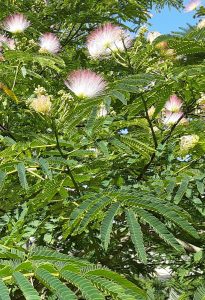
Persian Silk Tree
(Albizia julibrissin)
This species is named after an Italian nobleman, Filippo degli Albizzi, who introduced it to Europe in the mid-18th Century. The species name,”julibrissin”, is derived from a corruption of the Persian word for silk flower. It is a small deciduous tree with a broad crown of level or arching branches of large, frond-like, bipinnate leaves. The pink and white silky-thread-like flowers mature into large flat brown pods containing several seeds.
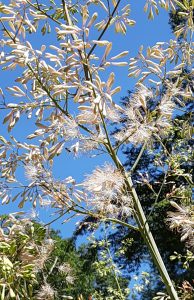
Plume Poppy
(Macleaya cordata)
This species is native to China and Japan, but has been introduced to the United States by gardeners. Escaping into the wild, it has become a noxious, invasive species, due to its ability to be self-seeding. It can grow up to eight feet in height, and be as much as three feet broad. It exhibits airy panicles of buff-white flowers which mature into five seeded grayish-brown seedpods. Its leaves are large and heart-shaped, thus its specific name, “cordata”.

Poison Hemlock
(Conium maculatum)
This biennial species is a large, much branched plant with finely divided, fernlike, dark green foliage. Its grooved stems are hollow and spotted with purple. It has an unpleasant smell when bruised. All parts of the plant are poisonous. Its juices are very poisonous. Its white flowers are carried at the end of a long stalk in a loose umbrel. In ancient Greece, it was used to poison prisoners, such as Socrates, condemned for having poisoned the minds of young men.

Poison Ivy
(Toxicodendron radicans)
This species can be found as a climbing vine or small shrub. It is characterized by having very small white flowers with green centers that are scattered along a stalk arising from the leaf axils. These mature into grayish or whitish berries. It has compound leaves consisting of three leaflets. It attaches itself to other vegetation by means of a hairy vine. All parts of the plant are poisonous, and contact with it can bring about a quick spreading rash. So, “Leaves of Three, Let it Be”.

Pokeweed (Poke)
(Phytolacca americana)
This species is a poisonous herbaceous perennial. It displays its simple, slightly-ovate, leaves and flowers upon a reddish stem. The greenish-white sepals of the flowers resemble petals, and are borne on a raceme. These mature into purple-black berries in drooping clusters on reddish stalks, which are a favorite food source for songbirds. During spring, shoots and leaves are edible with proper cooking. The berries were once used to make ink, thus a common name of “Inkberry”.
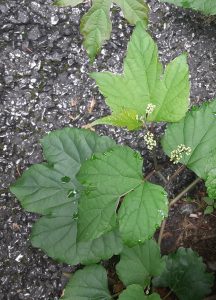
Porcelain Berry (Amur Peppervine)
(Ampelopsis glandulosa)
This species is an ornamental plant native to Asia that can be confused with grapes. It is a deciduous, woody, perennial climbing vine with flowers opposite its palmately lobed leaves. It climbs by tendrils to a height of twenty feet. The inflorescence is made up of small, green-white flowers born in umbels. These give way to many different colored berries, that can all be present on the same plant. It has become noxious and invasive, strangling other species.

Purple Loosestrife
(Lythrum salicoria)
This species is characterized by tapering spikes of slender, six-petaled magenta flowers often seen tinging swampy meadows. Its stems are reddish-purple and square in cross-section. Its leaves are sessile, lanceolate, wide at the based, downy, and opposite or in whorls of three. The fruit is a small capsule containing numerous minute seeds. It has been used as an astringent medicinal herb to treat diarrhea and dysentery. It is cultivated as an ornamental plant in gardens.
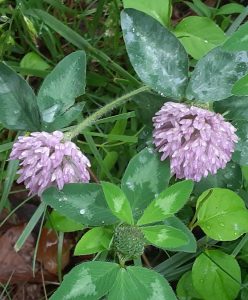
Red Clover
(Trifolium pratense)
This species of clover is distinguished by its round-headed, purple-red, flower heads. It is the familiar clover of fields and waysides. Its deep green, three-part leaves grow alternately from long petioles on the same stem as its flowers. They are generally marked by whitish chevrons. It has a deep taproot, which makes it tolerant to drought, and this, along with its ability to fix nitrogen in the soil, gives it a good soil structuring effect. It is widely grown as fodder.

Sallow Sedge
(Carex lurida)
This is a species of sedge and thus belongs to the Cyperaceae family. Like all sedges, it is characterized by having a triangular stem. Its flower sacs are small, slightly inflated, and with a straight beak. The female flower spikes, which are cylindrically shaped with many flower sacs, are found growing below the longer thinner male spike. It is found growing in clumps in swamps, marshes, and along pond and stream edges.
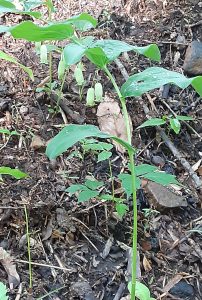
Smooth Solomon’s Seal
(Polygonaum biflorum)
This species exhibits paired yellow-green flowers that dangle from axils of alternate sessile leaves. When mature the seeds ripen into blue-back berries. It is said to possess scars on the rhizome that resemble the ancient Hebrew seal of King Solomon. Indigenous people consumed the starch-rich rhizomes, as a “potato-like” food, used it to treat gout and rheumatism, and used it to make breads and soups. The young shoots are edible both raw and boiled.

Smooth Sumac
(Rhus glabra)
This species is a spreading, open-growing shrub attaining heights up to ten feet. Its leaves are alternate, long, and compound with up to thirty oppositely paired leaflets, with each leaflet long with a serrated margin. The flowers are tiny, greenish-yellow, and produced in dense erect panicles. These later mature into edible crimson berries, which remain throughout the winter. This fruit is sour and contains a large seed, but can be made into a lemonade-like drink.
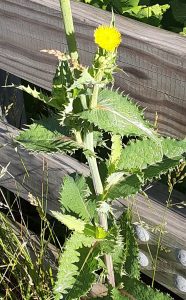
Spiny-Leaved Sow Thistle
(Sonchus asper)
This species is characterized by very spiny, curled leaves, whose eared bases enfold the smooth, angled stem. It has dandelion-like yellow flowers growing in small clusters at the top of each stem. The stems and leaves emit a milky sap when cut. The flower heads are devoid of disk flowers, containing only ray flowers in its composite head. Its edible leaves make a palatable and nutritious leaf vegetable. In many places, it is considered a noxious, invasive weed.
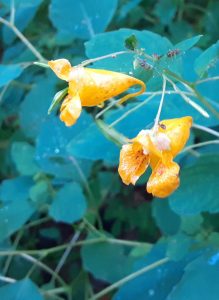
Spotted Touch-Me-Not (Orange Jewelweed)
(Impatiens capensis)
This orange flower is covered with red spots. It may be found growing alongside its common relative, Yellow Jewelweed. They both take their name from the characteristic that, when held under water, the leaves look like silver. Its other name comes from its seeds exploding from their capsules when touched. Juice from its stem can be an antidote for bee stings and poison ivy.

Sweet Vernal Grass
(Anthoxanthum odoratum)
This species is a short-lived perennial grass that grows in tufts with stems up to two feet tall. The leaves are short, broad, and loosely hairy. Its flower spikes are up to three inches in length with oblong shaped, crowded spikelets, which can be quite dark when young. As an agricultural grass it has a low yield, but can grow on land too acidic for other grasses. Its scent is particularly strong when dried.
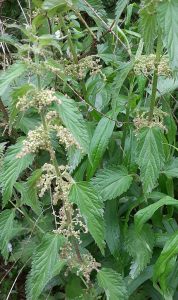
Tall Nettle
(Urtica procera)
This species is characterized by its stem, which bears many bristly, stinging hairs, that cause discomfort once touched. This is of short duration, and is sometimes called the “seven-minute itch”. Its flowers are greenish-white, slender, and found spreading or drooping as clusters from the rigid stem. Its leaves are lance-shaped or narrowly egg-shaped, rounded or slightly heart-shaped at the base. It can grow up to nine feet in height.

Venus Looking Glass
(Triodanis perfoliata)
This species is wand-like in growth. Its flowers are violet in color, with five spreading lobes, not bell-like, that are tucked singly in axils of roundish clasping leaves, that are scallop-edged and shell-shaped. It produces a small, many seeded capsule as its fruit. The Cherokee make a liquid compound of its roots infused into a bath for indigestion. It is native to North and South America, but has become naturalized in China, Korea, and Australia.
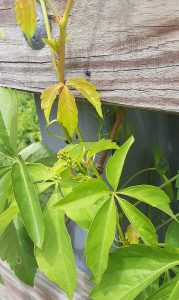
Virginia Creeper
(Parthenocissus quinquefolia)
This species is a vine in the Grape family, with leaves divided into five coarsely toothed leaflets that turn brilliant red in autumn. This accounts for the specific name, “quinquefolia”, meaning “five-leaved”. It is often confused with poison ivy, which has three leaflets. Its flowers are small whitish-green blossoms borne in branching clusters, that mature into bluish-black berries. Its tendrils end in disks, rather than penetrating roots, which make it ideal for climbing masonry.

Weeping Willow
(Salix babylonica)
This species is a medium-sized deciduous tree growing up to one hundred feet in height. Its leaves are long, and thin, and alternate along the stem. Its small, greenish yellow flowers are borne on catkins. The fruit is a small capsule, which splits open when mature to release the numerous, minute, down-covered seeds. Its roots are very bitter, and have been used as a substitute for quinine to treat fever, headache, and coughs.

White Clover
(Trifolium repens)
Like all clovers, this species is a member of the Pea family, and is the one most associated with lawns. Its tri-pinnate leaves are born on long petioles that grow from creeping runners. Each green leaf is marked by a triangular white chevron. The flowers are typical pea-like flower heads, which are generally white tinged with pink. It derives its scientific names from the Latin, “Trifolium”, meaning three leaves, and “repens” meaning creeping.

White Sweet Clover
(Melilotus alba)
This species belongs as named in the Clover family, and is, therefore a legume that can enrich soils by capturing elemental nitrogen from the air and converting it into nitrate in the soil. Its three-part leaves are cloverlike, but its flowers are not. Whether white, or yellow in a companion species, they are found in slender, tapering clusters. Its leaves are fragrant and often enhance the air, where it is growing. Its flowers are considered valuable honey plants, and are cultivated.

Wineberry
(Rubus phoenicolasius)
This species is a raspberry that was introduced from Asia. This plant is a perennial but exhibits biennial characteristics only producing flowers and fruit every other year. It has a compound leaf with three leaflets that are white underneath. The flowers have five red to pink petals on a bristly calyx growing from a short, very bristly raceme. The fruit is orange or red. The stems have red glandular hairs, giving it its scientific name from the Latin “phoenicus”, meaning red.
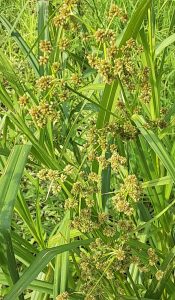
Wool Grass
(Scirpus cyperinus)
This species is a sedge of variable appearance that grows in dense clumps in many types of wet habitats. The fertile stems grow upright. There are five to ten extremely long leaves per stem. The inflorescence has upright or spreading branches bearing cymes of up to fifteen cylindrical or oval spikelets each. The flowers have six long bristles each, making the inflorescence look wooly. Indigenous people used it to make bags and mats or stuff pillows.
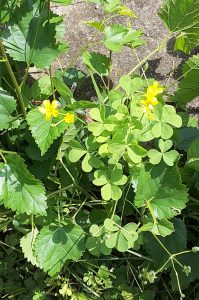
Yellow Wood-Sorrel
(Oxalis stricta)
This species is characterized by its leaves, which are comprised of three petals and look much like a shamrock rather than a clover. The flower is a five-petaled yellow blossom carried at the end of a long stalk. It matures into a seedpod which is held at a sharp angle to its bent stem. Flowers sometimes reddish at base. All parts of the plant are edible, and It is commonly called “Sourgrass” due to its distinct tangy flavor from the oxalic acid stored in its cells.
Common Autumn Plants

Beefsteak Plant (Korean Perilla)
(Perilla frutescens)
This plant is a member of the mint family and is characterized by pink flowers growing on a raceme from its square, hairy stem. Its leaves are opposite, long, wide, and oval-shaped with pointy ends and saw-toothed margins that are green to purple in color. It is an annual plant native to Southeast Asia and grown in Asian gardens, where it is used as a crop for its edible leaves and seed oil. In the United States, it is a pest and toxic to horses and cattle after ingestion.

Black Fountain Grass
(Cenchrus purpuroscens)
This is a perennial tufted grass that grows in slowly-expanding dense clumps up to three feet in height. It bears narrow, green, smooth, scaly leaves with purple flowers in a cylindrical foxtail-like spiked inflorescence. It is planted as an ornamental as it is easy to grown. It will grow in dry even infertile soils. It is little affected by drought and is pest resistant. It is wind pollinated, so does not need to be colorful or fragrant to attract pollinators.
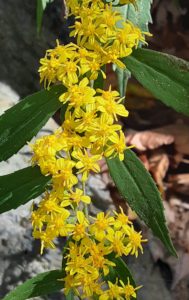
Blue-Stemmed Goldenrod
(Solidago caesia)
This species is one of many in the Goldenrod Family that is native to North America. It is characterized by a dark, wiry, blue to purple stem from which grow smooth, slender, alternate leaves. At the leaf axils can be found well-spaced flower tufts of yellow flower heads instead of the customary goldenrod pattern of large arrays at the top of the plant. It prefers medium to partial shade, so can often be found in wooded areas.

Boomsedge Bluestem Grass
(Andropogon virginicus)
This is a perennial grass which may form narrow clumps of stems that may attain heights of up to three feet. In its early days, its stems and leaves are green. But with tine, they will change and become purplish to orange, and finally to straw-colored. Inside these leaves will be tucked its flower stalks. It is a prolific seed producer that produces many seeds that are small enough to be dispersed on the wind. These are aided by silvery-white hairs that surround each flower.
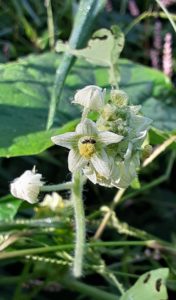
Bur Cucumber
(Sicyos angulatus)
This species is an annual climbing vine from the gourd family. It climbs by means of tendrils and may form large mats of hairy, pale-green, furrowed stems with alternate, lobed, palmately veined, maple-like leaves. Like its tendrils, its flower clusters are found in its leaf axils. It is monecious, with male and female blooms on separate stalks. The female flowers are five petaled and green to yellow in color. They produce hairy clustered fruits, each with a single seed.

Chinese Silvergrass
(Miscanthus sinensis)
This species is a perennial grass that was introduced to the United States as an ornamental in the nineteenth century, but did not become popular until the late twentieth century when it became a favorite planting in both residential and institution gardens due to its drought tolerance. It is characterized by a large, plumy, purplish inflorescence topping a single stem with long, thin, narrow leaves. It grows in clumps that may attain heights as tall as twelve feet and be invasive.

Clearweed
(Pilea pumila)
This species is an annual, nettle-like in appearance, but shorter and devoid of stinging hairs. Its leaves are opposite, simple, ovate, and with relatively few teeth. They grow on long petioles. Its greenish-yellow flower clusters are short, curved, and drooping, found in the leaf axils, unisexual with both genders on the same plant, and pollinated by the wind. Its stem is smooth and translucent, thus its common name. It thrives in wet places. It is edible but unpalatable.

Climbing False Buckwheat
(Fallopia scandens)
This species is a twining vine, so, using other items or plants, it can attain heights up to fifteen feet. Its stems are rough and reddish in color. Its leaves are simple, arrow-shaped, and grow singly spaced along the length of the vine. Its greenish-white flowers are exhibited in a slender, showy, spray. Although they are semi-erect when blooming, they hang in a downward position when producing their buckwheat shaped fruit from which they take their name.
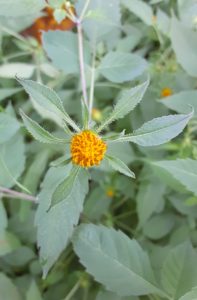
Devil’s Beggar Ticks
(Sticktights)
(Bidens frondosa)
This species is in the Aster family. It is an annual that may grow as tall as six feet. Its stems are square and hold pinnate leaves that are divided into a few toothed lance-shaped leaflets. The flower head contains many orange disc florets which may or may not be surrounded by a few yellow rays. The fruit has a flat black to brown body with two obvious hornlike pappi. For seed dispersal, these are barbed and help them stick to animal fur and human clothing.
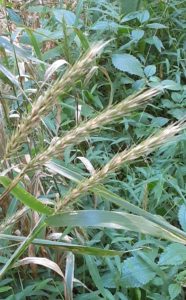
Eastern River Bank Wild-Rye
(Elymus virginicus)
This species is a native, cool season, perennial bunch grass. Its foliage is greenish to silver blue and it grows to four feet in height. Its slender leaves and stem are smooth. Its inflorescence is stiff, upright, and compact with hard textured single flowers growing in clusters. These display stiff, straight bristles that rise from the clusters. It prefers heavy, fertile soils, but is extremely adaptable. It is extremely palatable to livestock, but should be harvested early to prevent disease.
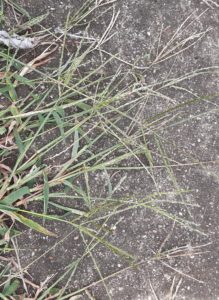
Hairy Crabgrass
(Digitaria sanguinalis)
This species of annual grass is best known as a most unpopular weed of suburban lawns and gardens. It can grow to heights of four feet from sprawling clusters of linear basal leaves. The leaf sheaths are peppered with hairs that have a pimply base. Its inflorescence is arranged in a long line of single flowers then seeds and radiates mainly from the top of a long stem. There may be as many as nine branches radiating from the main stem. It is cultivated as a forage crop.
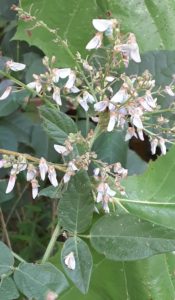
Hoary Tick-Trefoil
(Desmodium canescens)
Tick-Trefoils are members of the Pea Family and thus valuable as legumes that enrich the soil by fixing nitrogen. They are slender plants with small, pink, lavender, purplish, or white flowers in loose racemes. These ripen into jointed pods, with triangular joints. These adhere to animal fur and clothing helping in dispersal. This species is much branched whose petioles and stems are finely hairy or pubescent and often sticky.
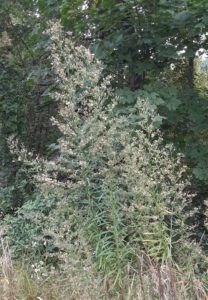
Horseweed
(Erigeron canadensis)
This annual plant grows up to five feet in height on sparsely hairy stems. Its leaves are unstalked, slender, up to four inches in length, with a coarsely toothed margin. They grow in an alternate spiral up the stem. The flowers are produced in dense inflorescences with each individual flower having a ring of white or pale purple ray florets and a center of yellow disc florets. The seeds are tipped with a white down.
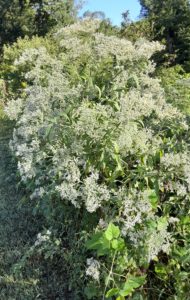
Late Flowering Thoroughwort
(Eupatorium serotinum)
This plant is also known as Late Boneset due to its fall blooming season. Like other members of Eupatorium it grows up to nearly seven feet in height, but its leaves are stalked on purple stems. It has dense inflorescences containing a large number of tiny white flower heads with nine to fifteen disc florets but no ray florets. It is insect pollinated unlike other species of Eupatorium that are pollinated by the wind.
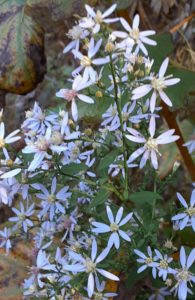
Lowrie’s Aster
(Aster lowrieianus)
This species can reach heights of up to four feet. The lower leaves are heart-shaped, most typically with flat, winged petioles. These leaves are smooth with a greasy feeling. Its flowers are composite with bluish to rarely white ray florets and light-yellow disc florets that eventually turn purple. These are displayed on open panicles or erect racemes. This species reproduces vegetatively by way of short rhizomes, as well as by wind-dispersed seeds

Mild Water Pepper
(Polygonum hydropiperoides)
Along with the Smartweeds, this species is in the Buckwheat Family. In this species the slender pink or white flower spike is usually sparse and more or less interrupted. It has simple, linear leaves which grow from a weakly erect stem. The stem sheaths at the joints have a fringe of slender bristles. Unlike a similar species, its leaves have a less acrid peppery taste. It can be found in shallow water or wet shorelines.

Mugwort
(Artemisia ulgaris)
This is a tall perennial plant growing up to two and one-half feet in height. It spreads through dispersal of root rhizome fragments rather than seed dispersal. The leaves are dark green, pinnate and sessile, with dense, white hairs on the underside. The erect stems are grooved and have a red-purplish tinge. It has rather small florets with yellow or dark red petals.

Rough-Stemmed Goldenrod
(Solidago rugosa)
This species is characterized by having wrinkled, deeply toothed, feather veined leaves. These alternate along a densely hairy stem. The rough lower leaves are variable but generally are broad and taper into a margined stalk. The yellow flowers are composite with several rays surrounding a central disc. These are small and arranged along a many-branched raceme that ends in a plume-like cluster at the top of the plant. It is a great pollinator for bees.

Slender Beadgrass
(Paspalum setaceum)
This perennial grass can grow erect or from prostrate stems. It can grow to nearly three feet in length. The generally green leaf blades are flat and usually hairless to mildly hairless. Its green flowers then seed pods are borne on a panicle that may have up to six branches and be six inches in length. These seedpods are small and oval to round in shape and are lined along only one side of the stem. It grows in tufts in fields and along woodland edges.
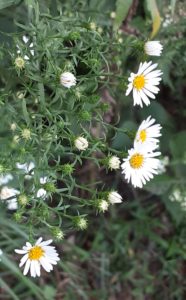
Small White Aster
(Aster vimineus)
This is one of the many species within the Aster family. Aster is derived from the Greek and Latin words for “star” just as in asteroid. This name comes naturally from their many ray flowers around a central cluster. Small white daisy-like flowers that are crowded closely together along purple stems characterize this species. It may grow as high as five feet in fields and meadows with partial shade.

Sweet Goldenrod
(Solidago odoera)
This species of Goldenrod is characterized by having linear, alternate leaves that are parallel-veined. These leaves are slender, toothless, smooth, and show transparent dots. It can grow up to heights of six feet on smooth stems. Its flowers are borne in graceful plumes from the top of the plant. These yellow flowers have very slender yellow rays that are held erect above a composite disc. Its crushed leaves emit a sweet, anise-like odor and dried can be used as a tea.

Virginia Stickseed (Beggar’s Lice)
(Hackelia virginiana)
This is a species is a biennial plant characterized by tiny whitish flowers borne along one side of a long raceme rising from a widely-branched, finely hairy, ribbed stem. Its stem leaves are elliptical or lance shaped with basal leaves being large and more ovate. These are usually absent at the time of flowering. The fruit is a round pricky bur that clings to fur or clothing aiding in its dispersal. During its first year of growth, it appears as only a basal rosette of foliage.
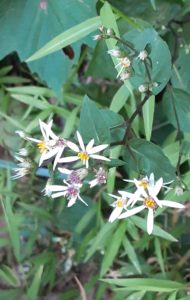
White Wood Aster
(Aster divaricatus)
This species is a late-summer to fall-flowering perennial emerging each year from rhizomes to form dense colonies. It exhibits three types of leaves. Basal leaves are ovate and heart shaped. Stem leaves are also ovate but have petioles that are often winged. Top leaves are generally lanceolate and sessile with no petiole. The flower heads are arranged in flat topped arrays. They are composite with white rays centered around a disc of yellow florets.

Witch Hazel
(Hamamelis virginiana)
Witch Hazel is a small deciduous shrub that grows up to about twenty feet in height. Its heavily veined leaves are oval with a wavy-toothed or shallowly lobed margin on a short petiole. Its flowers are pale to bright yellow with four ribbon-shaped petals around four central stamens and a stigma. They grow in clusters. It is a surprisingly late bloomer flowering in late fall. The flower produces a fruit which is a hard woody capsule that ejects two shiny black seeds a year later.

Yellow Foxtail Grass
(Setaria pumila)
Species of this genus have a flexible cylindrical inflorescence with many short fine hairs. If you squeeze it through your hand, it will wiggle like a wooly bear caterpillar. This species can be distinguished from the more common Chinese foxtail by several factors. First, it is a late bloomer arriving only at the end of summer. Secondly it grows erect, not nodding. Finally, its hairs are yellow not green. Like others of its species, it produces abundant seeds fed on by many birds.